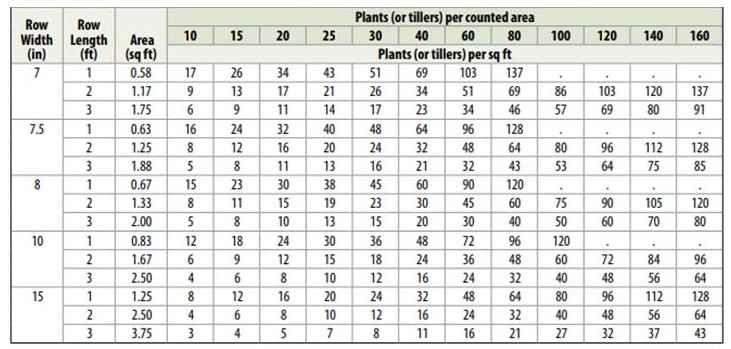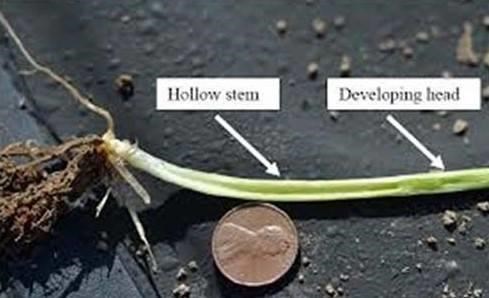The first one requires and yardstick or dowel rod 3 ft. in length.
1. Make spring stand counts before green-up of the plants occurs to determine if winter damage has reduced the initial plant population obtained in the fall. Count only whole plants, not tillers. Fields with stand counts below 15 plants per square foot have less than 75 percent yield potential (Table 1) and probably should not be kept but used instead for planting corn or soybeans. If stand counts are adequate to keep but somewhat reduced from optimum, consider an early nitrogen application.
Table 1: Wheat Yield potential based on plants per square foot
| Final Stand (%) | Plants per sq.ft. | Plants per sq.yd. | Potential Yielda (%) |
|---|
| 100 | 30-35 | 270-315 | 100 |
| 80 | 24-28 | 216-252 | 100 |
| 60 | 18-21 | 162-189 | 90-95 |
| 50 | 15-18 | 135-162 | 75-80 |
| 40 | 12-14 | 108-126 | 60-70 |
| 20 | 6-7 | 54-63 | 40-50 |
a This provides and estimate of the relationship of wheat stand to yield potential and is only a guide. Many factors (plant vigor, weather, disease, fertility management, planting date, and variety) influence how a wheat stand ultimately responds to achieve its final yield potential.
2. To determine the number of plants per square foot:
- Use a yardstick or cut a dowel rod to a 3-foot length.
- Place the measuring stick next to an average-looking row and count all plants in the 3-foot length of the row.
- Record the number.
- Repeat the counting process in at least five other locations well-spaced around the field. Record all numbers.
- Average all the stand counts from the field.
3. Last, calculate plants per square foot with the following equation:
- (average plant count × 4)/row width in inches
Second Method
A second method to counting stands is to determine the length of row needed to equal one square foot (Table 2). Mark the needed length on a dowel rod or stick and then count the plants in a row.
Table 2: Length of row needed for 1 sq.ft.
| Row Width (in) | Row Length for 1 sq.ft. (ft) | Row Length for 1 sq.ft. (in) |
|---|
| 6 | 2.0 | 24.0 |
| 7 | 1.7 | 20.6 |
| 7.5 | 1.6 | 19.2 |
| 8 | 1.5 | 18.0 |
| 10 | 1.2 | 14.4 |
| 15 | 0.8 | 9.6 |
A third method from Kentucky Extension is to count the plants, or tillers in 1, 2 or 3 feet of row and use Table 3 to determine stands. Taking a tiller count which includes main shoot and tillers at Feekes 3 (roughly Zadoks 22 through 26) is the first step in all fields for determining nitrogen needs in late winter or early spring. To determine tiller numbers, count all stems with three or more leaves. Tiller counts below 70 per square foot indicate the need for nitrogen at Feekes 3. At recommended populations, many plants will have only three to four stems (main shoot plus two to three tillers, Zadoks 22 or 23). Thus, 70 to 100-plus tillers (stems) per square foot at Feekes 3 are considered adequate.
Table 3. Wheat Stand Count Table

Final Thoughts
As you assess your fields you may find large areas of the field may be drowned out in low lying spots. If these areas make up most of the field area it might be worthwhile to consider rotating out of wheat and into a corn crop to utilize any N that may have been applied and or soybeans depending on which herbicides were applied and their respective replant restrictions.
Many fields are moving into the stem elongation phase and nitrogen management becomes important. There are some stands that had 30-50 lbs. of actual N applications early and those stands are really pushing at this time. Others are just breaking dormancy and are still in the tillering phase of growth. Picture below was taken in 2018 but it does illustrate the importance of the developing head location and as this tiny head begins moving upward growers need to ensure N is ideal but care not to burn the crop and or otherwise injure this critical structure. 1 lb of N per bushel is the key to ensuring adequate yields. If your goal is 80 bu per acre you will need to supply 80lbs of N available to achieve that yield goal.

Source : psu.edu